Since Robbie Neilson’s return as manager, Hearts have won promotion to the Scottish Premier League, reached two consecutive Scottish Cup finals, and qualified for UEFA Europa League for the first time since he was a player for the Jambos back in the 2004/05 season.
But prior to his re-appointment, it had been a tumultuous ride for the Edinburgh club. Relegated amid a COVID hit 2020 when 81% of all 42 professional clubs voted to cancel the season – a decision chairman Ann Budge challenged, costing the side £646,000 in court bills – Hearts endured an uncertain pre-season hampered by pay cuts, lockdowns, a ban on training (despite Hull City and West Ham being able to use their facilities) and uncertainty over which league they would play in.
In this tactical analysis, in the form of a scout report, we’ll see how Neilson has got the Hearts team pumping after a bloodless season led them to the bottom of the Scottish Premier League to immediate promotion and finishing third in the SPFL, a position they’ve occupied for the last two seasons. This will be an analysis of the tactics implemented by the manager at Hearts.
Formations used
A fundamental part of Neilson’s tactics is to pass the ball into areas of the pitch rather than to specific players: this allows for a more flexible attitude towards formations, with seven types being used so far this season. Hearts have lined up with 4-2-3-1 against Livingston, Dundee United, and Riga, 3-4-3 against Kilmarnock and St Johnstone, and a more conservative 4-4-1-1 and 5-3-2 in the Europa League against Basaksehir and Zurich.
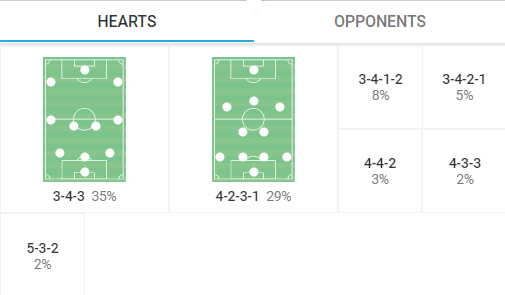
Clearly, Neilson is not precious about using particular formations. In their Championship season, the Hearts manager was happy to use two holding midfielders in an attempt to dominate the centre of the pitch and a flat-back four in the 2020/21 season, relying mostly on a 4-2-3-1 or 4-4-1-1.
In defence, Hearts were solid, only losing four games in a season that saw skipper Craig Gordon keep 11 clean sheets in a row. In attack, they were a little one-dimensional as they relied mostly on the right wing as Aidy White was often unsuccessful in a two versus one situation on the left.

The Hearts diamond
Neilson has made sure that his Hearts side are playing traditional, no-nonsense football – the forwards score, the wingers and attacking midfielders provide the goals, and one defensive midfielder protects the back line – but with a twist.
Regardless of the formations used, Hearts tend to play patient football at the back, frustrating the opposition enough to encourage them to press before playing the ball out wide where it is then brought back into the centre of the pitch further up the field, effectively playing the ball in a diamond shape. Balls through the centre are discouraged.
Below, the Hearts defence play the ball to Jorge Grant, sitting just in front of the back three, inviting the press from Dundee United’s Ian Harkes and Tony Watt. The ball is then played back to the defensive line, now alleviated from any pressure, who can then play the ball out wide to Alex Cochrane. Cochrane then carries the ball before hitting an early cross to the open Lawrence Shankland who does what he does best in finding space in the back line to run through.

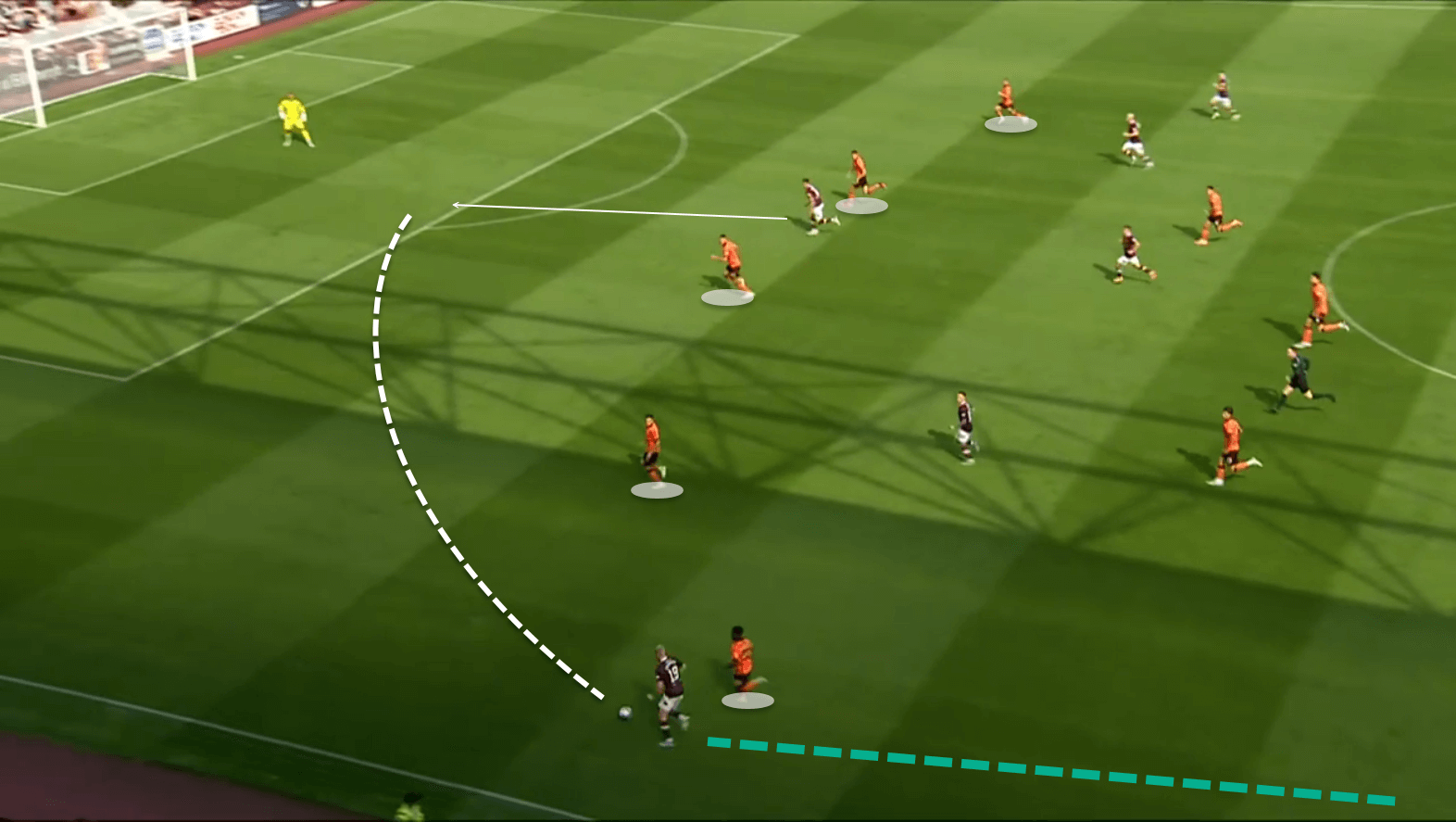
Below, we can see the same tactic used in last season’s derby against Hibernian. The ball is played around the back line before it’s passed out wide to Barrie McKay, who launches the ball up towards Liam Boyce from within his own half.

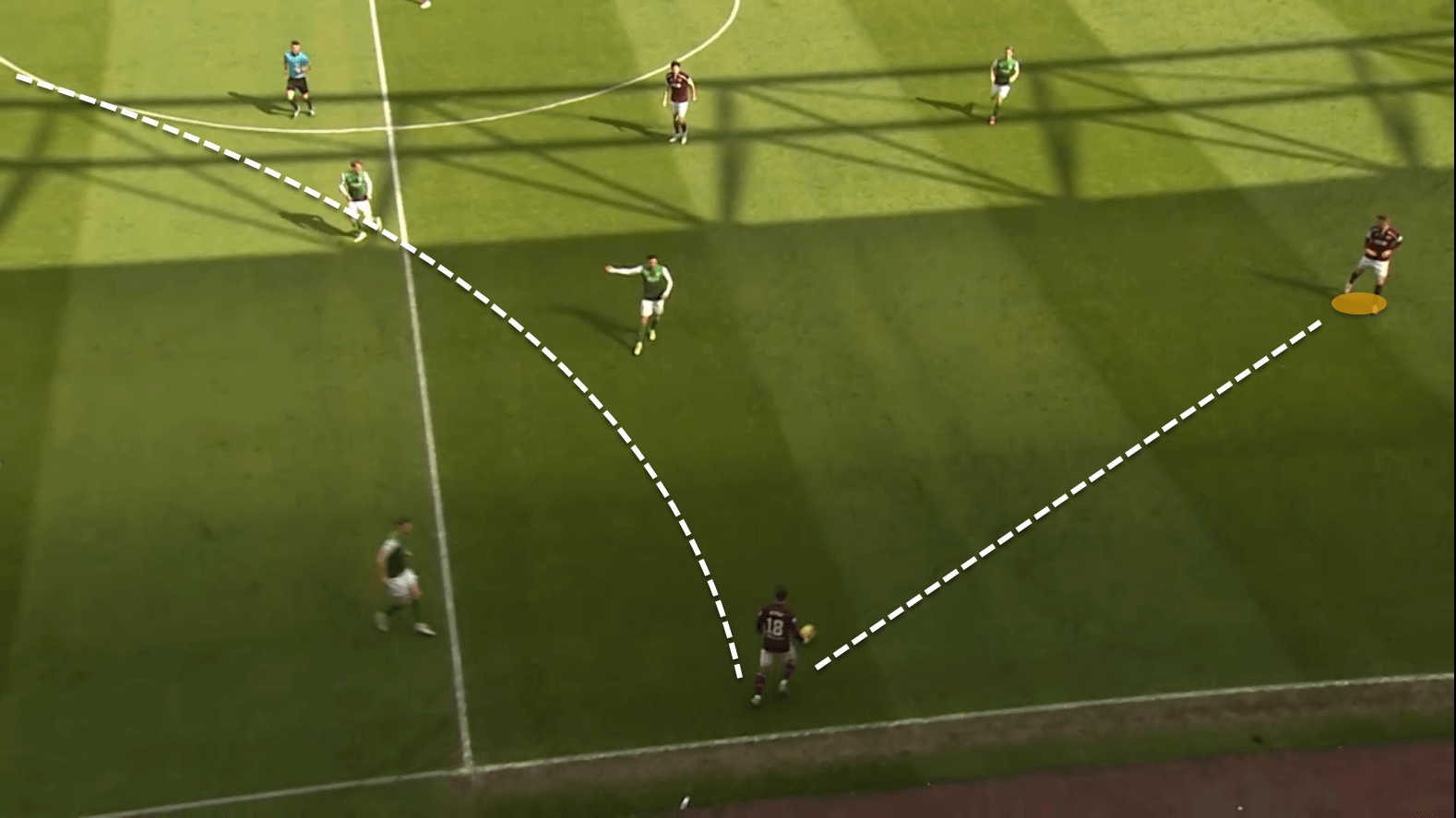
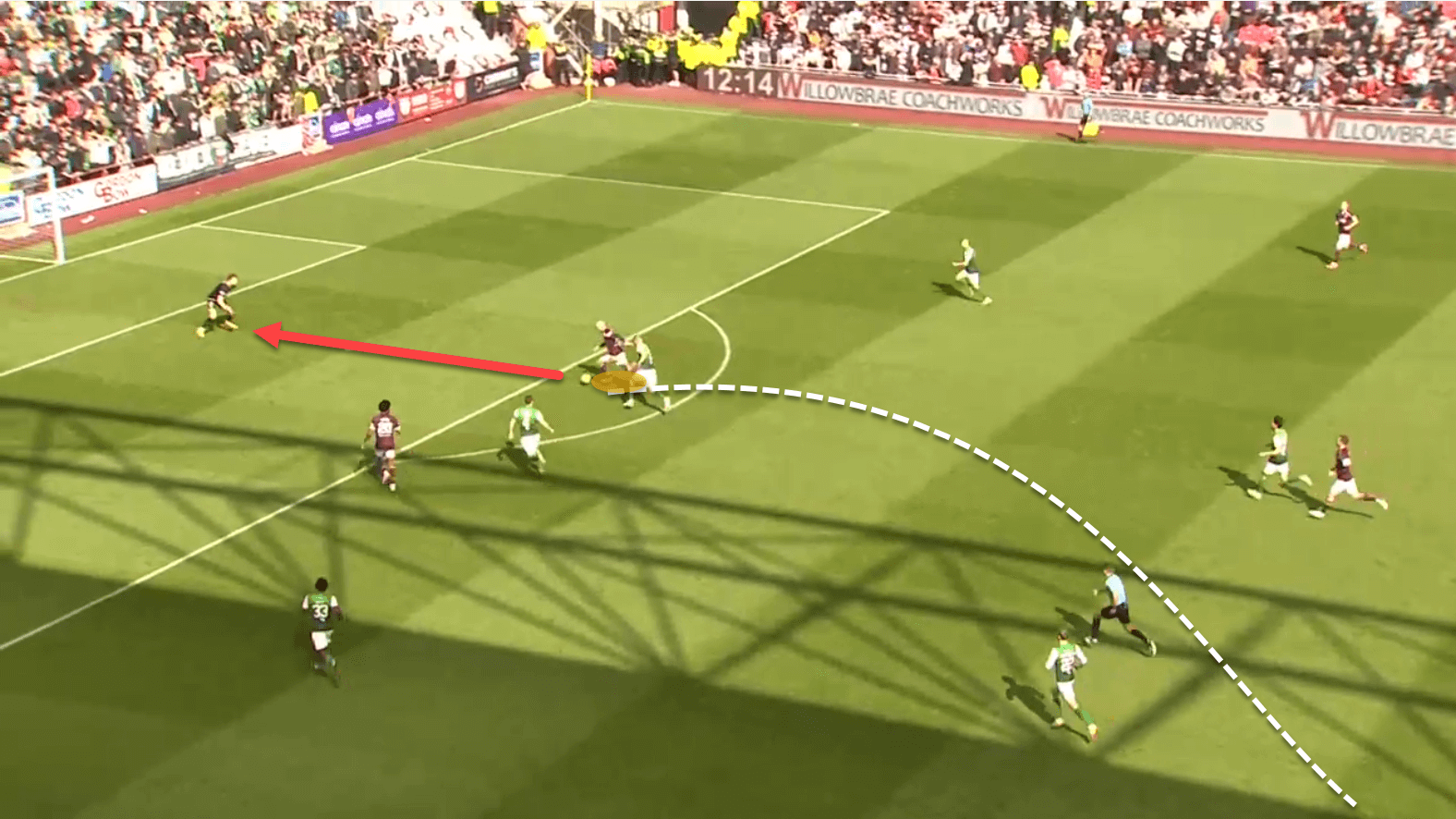
Below, Hearts press Hibs in their own half, with McKay carrying the ball forward to invite the press from Hibernian’s Elias Melkerson, creating space for Toby Sibbick who received the ball before passing out wide to Nathaniel Atkinson, who then brings the more central Ellis Simms into play.
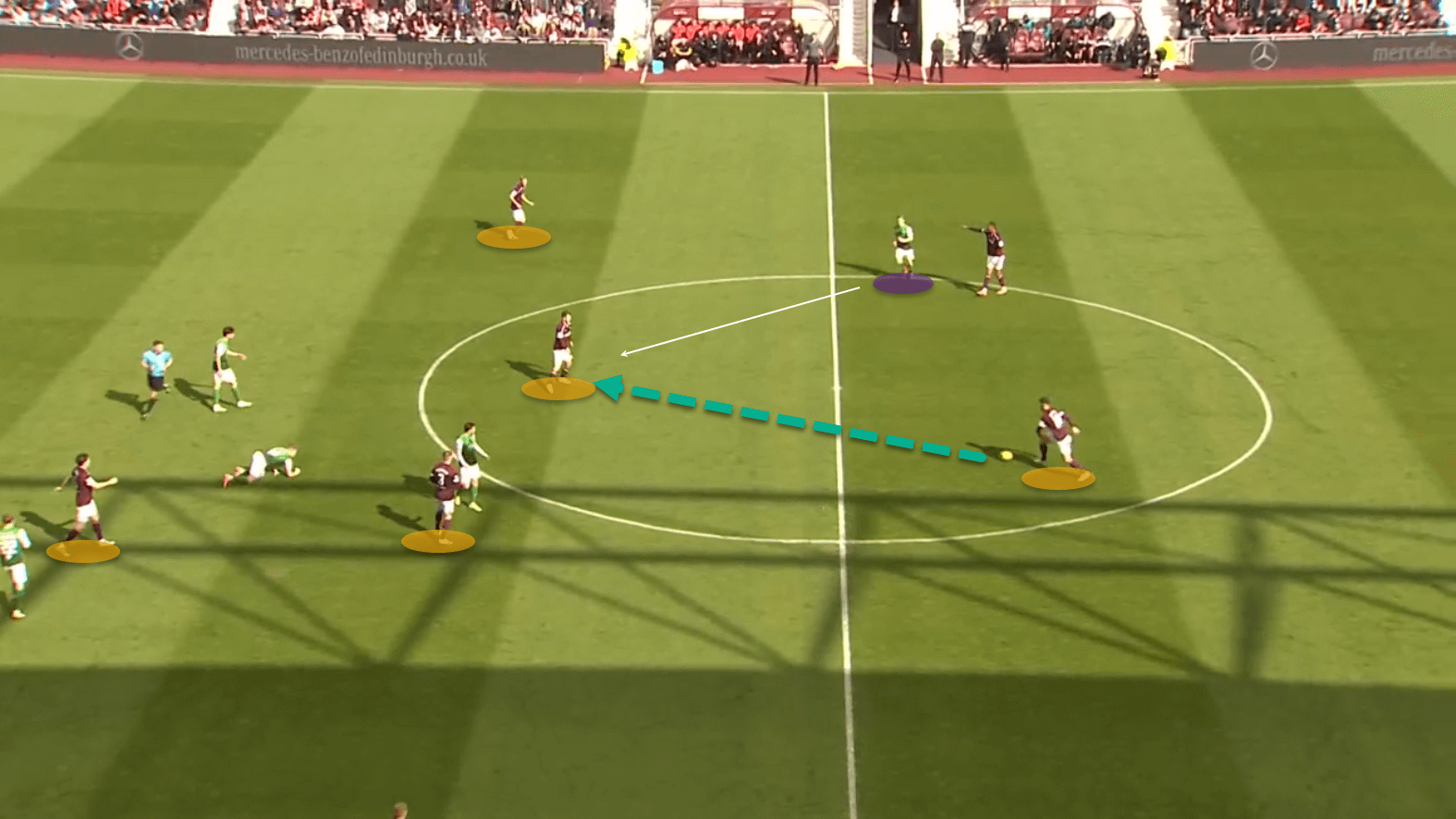
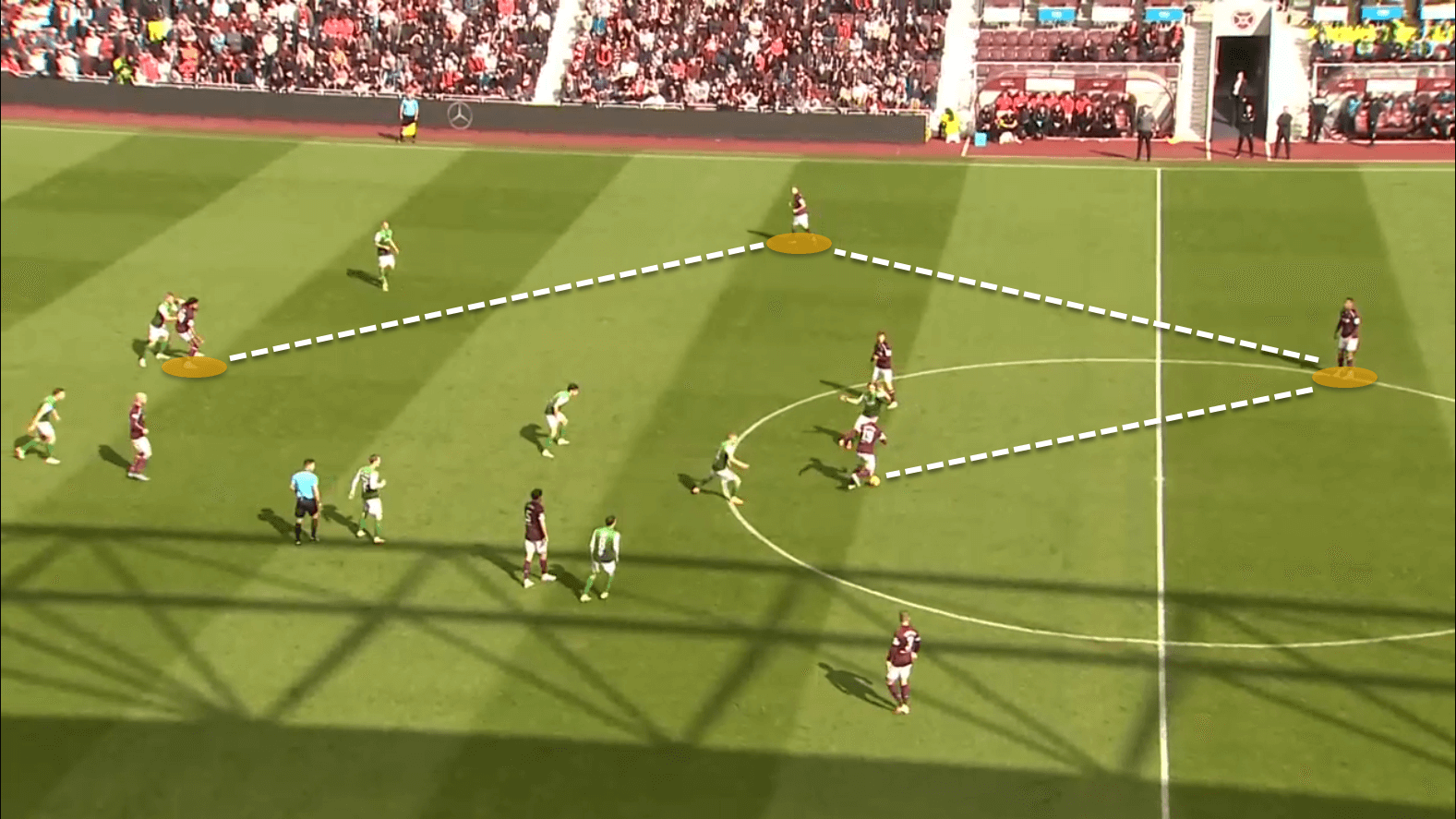
Neilson has Hearts playing open football on the front foot: this season they have had an average of 12.4 shots per game (with 5.1 shots coming from outside the box), scoring 13 goals in 7 matches, an average of 1.86 goals per game, a goal every 48 minutes, and currently sit fourth in the league for goals scored.
The best defence is not always attack
Due to their attacking intent, they have only managed to keep one clean sheet in the SPFL this season, in a 3-0 away win at Motherwell, and have conceded every 79 minutes. Most goals have been scored in the second half of their games, having gone into the break one nil up/down in five games out of seven, 13 goals have been scored in the last 45 minutes. The last 10 minutes of games have seen the most amount of goal activity, where 23% of goals have been scored, reflected in their 90th-minute goal against Motherwell, a 94th-minute goal conceded in the 2-0 loss to Celtic, and a 95th-minute equaliser conceded in the Edinburgh derby at Easter Road back in August.
As Neilson has commented regularly on his team’s work ethic, this suggests the opposition are able to take advantage of their tiredness and drop in concentration towards the end of the game. Defensively, Hearts regroup behind the ball and choose to sit back in a low block, waiting to regain possession before players can reposition themselves into their attacking shape to begin to play from the back. This standing off of opponents has been their undoing, as opposition teams often play around the Hearts players or walk through the centre unopposed.
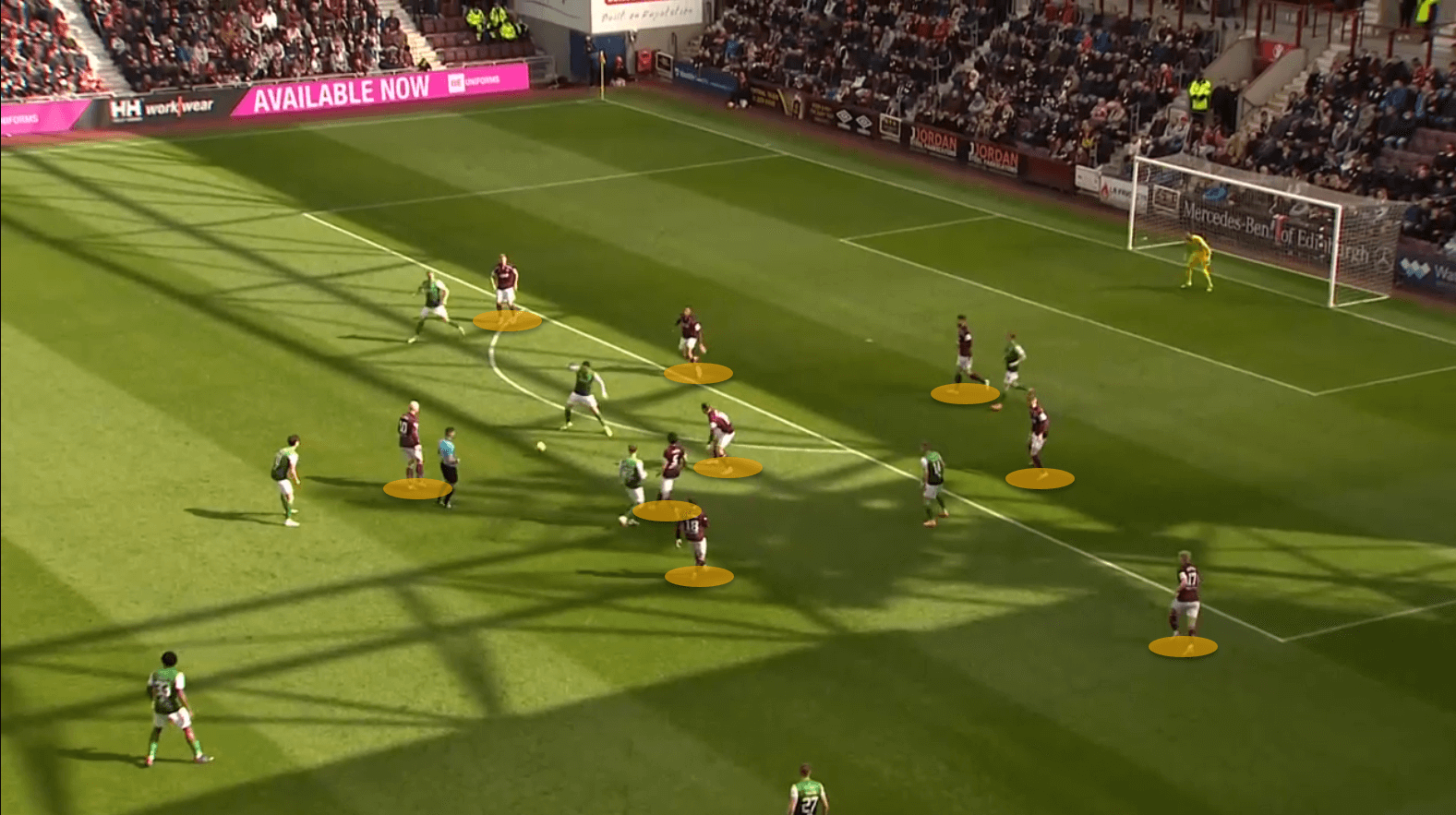
In the 3-1 loss to Rangers last season, pictured below, we can see Cole McKinnon play a one-two through the centre of the park with Alex Lowry. McKinnon then plays another one-two at the edge of the box, receiving the ball without pressure and unmarked by the Hearts defence, who are caught ball watching as McKinnon quickly slots the ball past Craig Gordon. The move started with Rangers goalkeeper Jon McLaughlin, and after six passes, the ball went into the back of the Hearts’ net within 15 seconds with zero pressure or desire to stop the shot from the Hearts defence, who looked to have completely switched off.
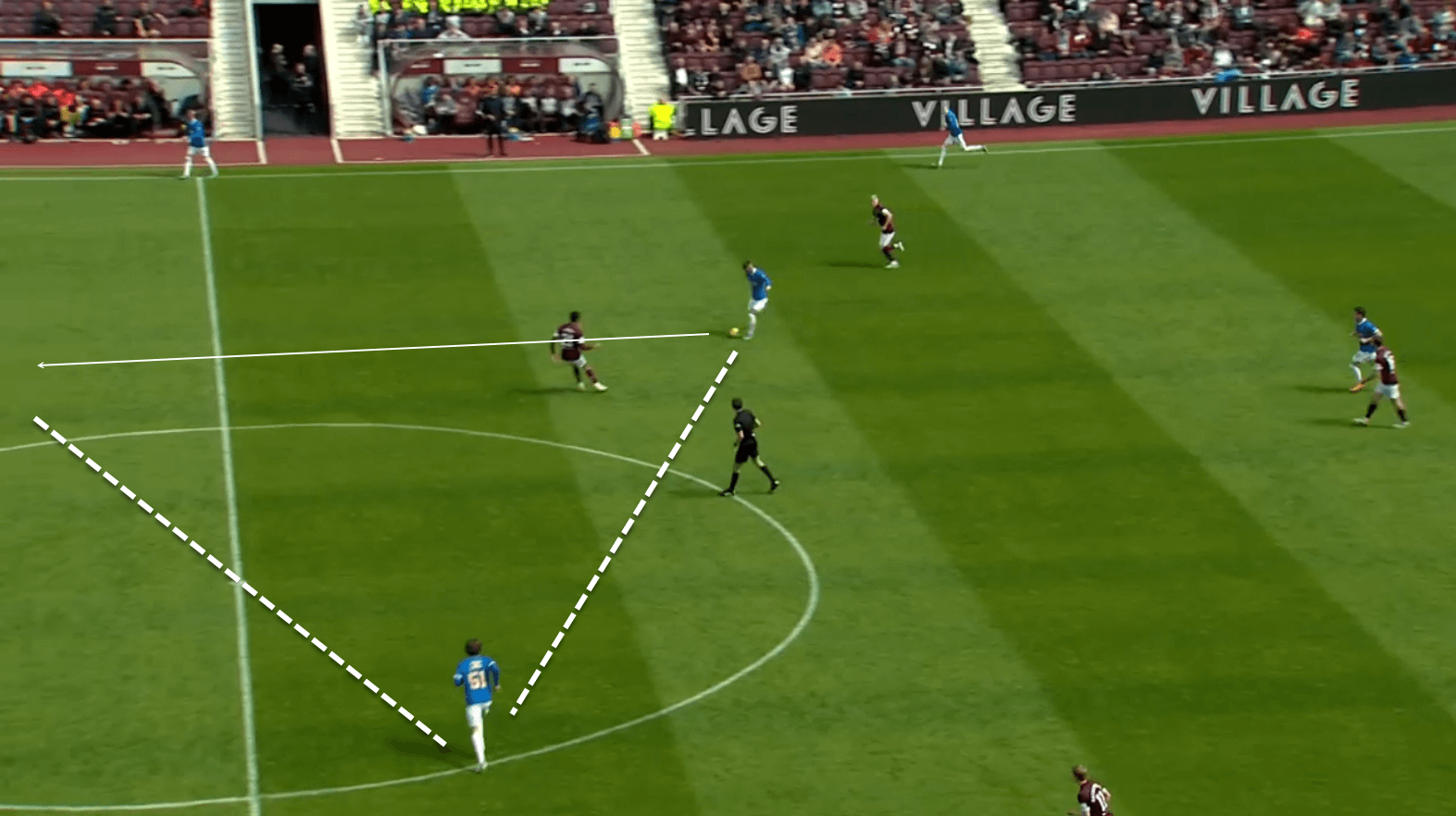

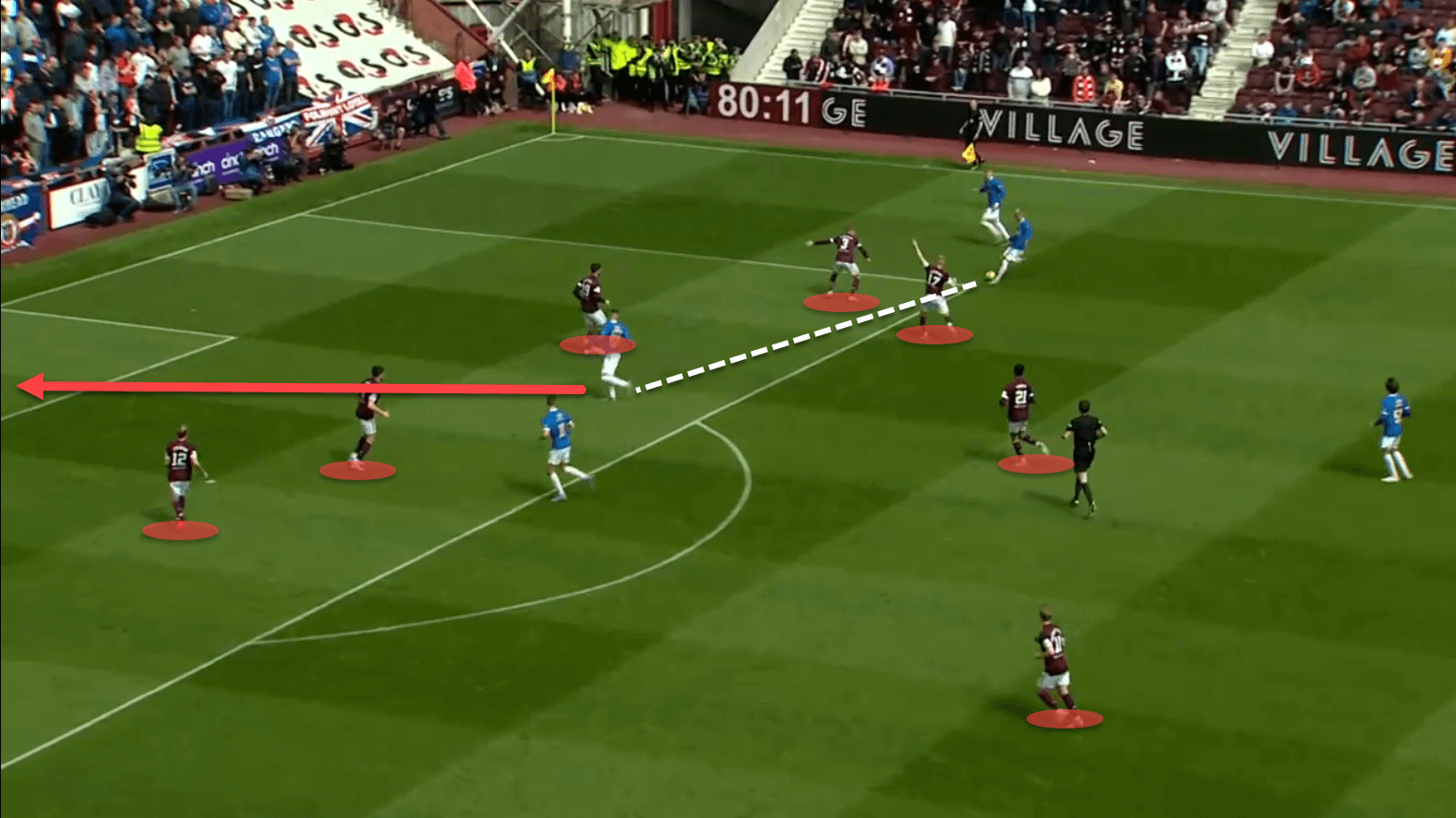
In another example of Hearts’ lack of pressing and/or drop in concentration, we see Celtic’s Cameron Carter-Vickers play the ball to David Turnbull, who cuts inside to carry the ball towards the wing where he releases an unmarked Daizen Maeda, who crosses for Kyogo Furuhashi, who, despite having three Hearts players in close proximity, falls into the gap unnoticed.
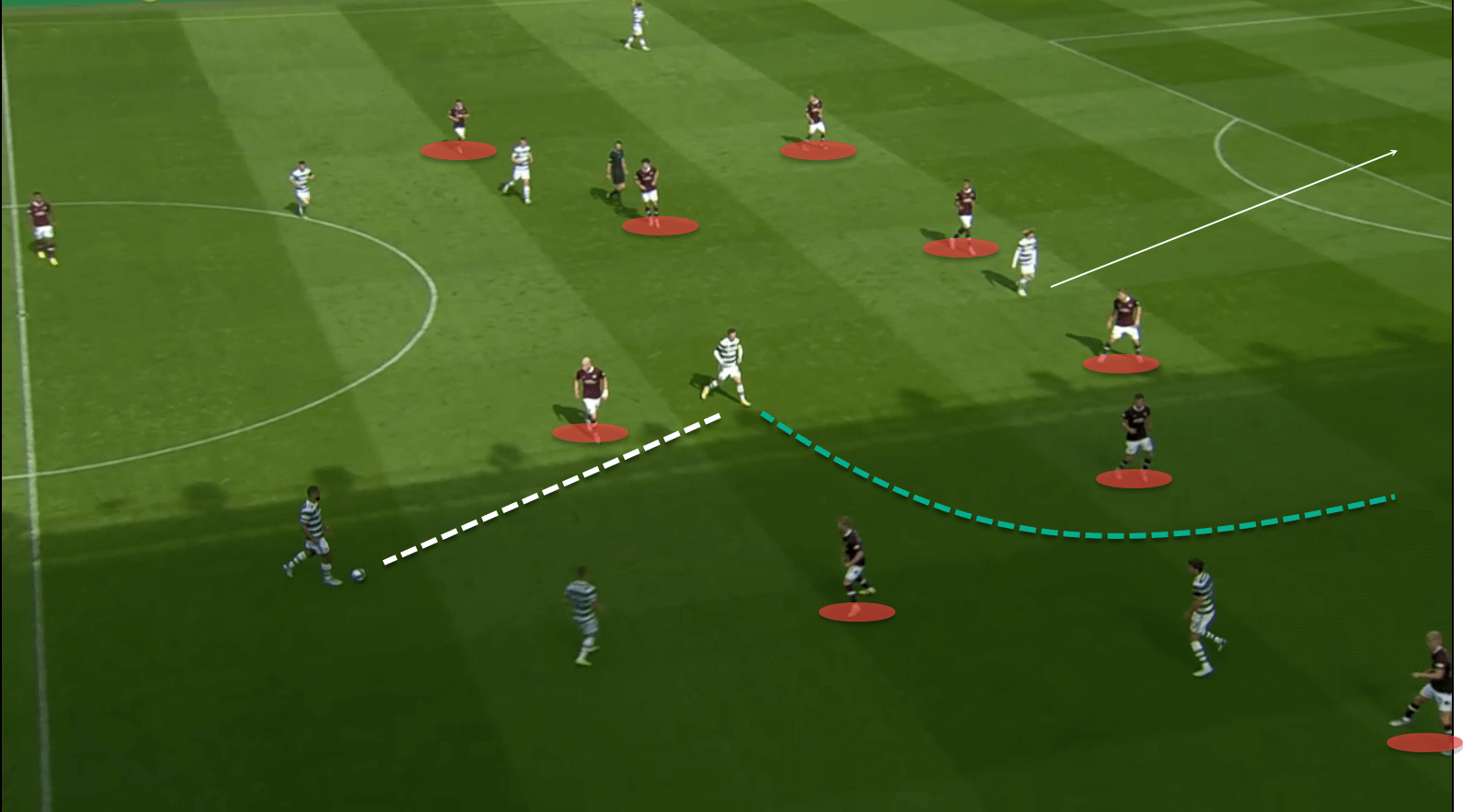

Neilson has often been accused by his own fans of not trying when playing against Rangers and Celtic, but the same defensive frailties are exposed against Motherwell, pictured below in their last game, a 3-0 win over Motherwell. In the first image, we see a ball from Sondre Johansen bypassing five Hearts players on its way to the wing, where Sean Goss crosses into the box for Kevin van Veen to head onto an unmarked Joseph Efford, who is in acres of space and is only denied when Gordon rushes out to stop the shot.
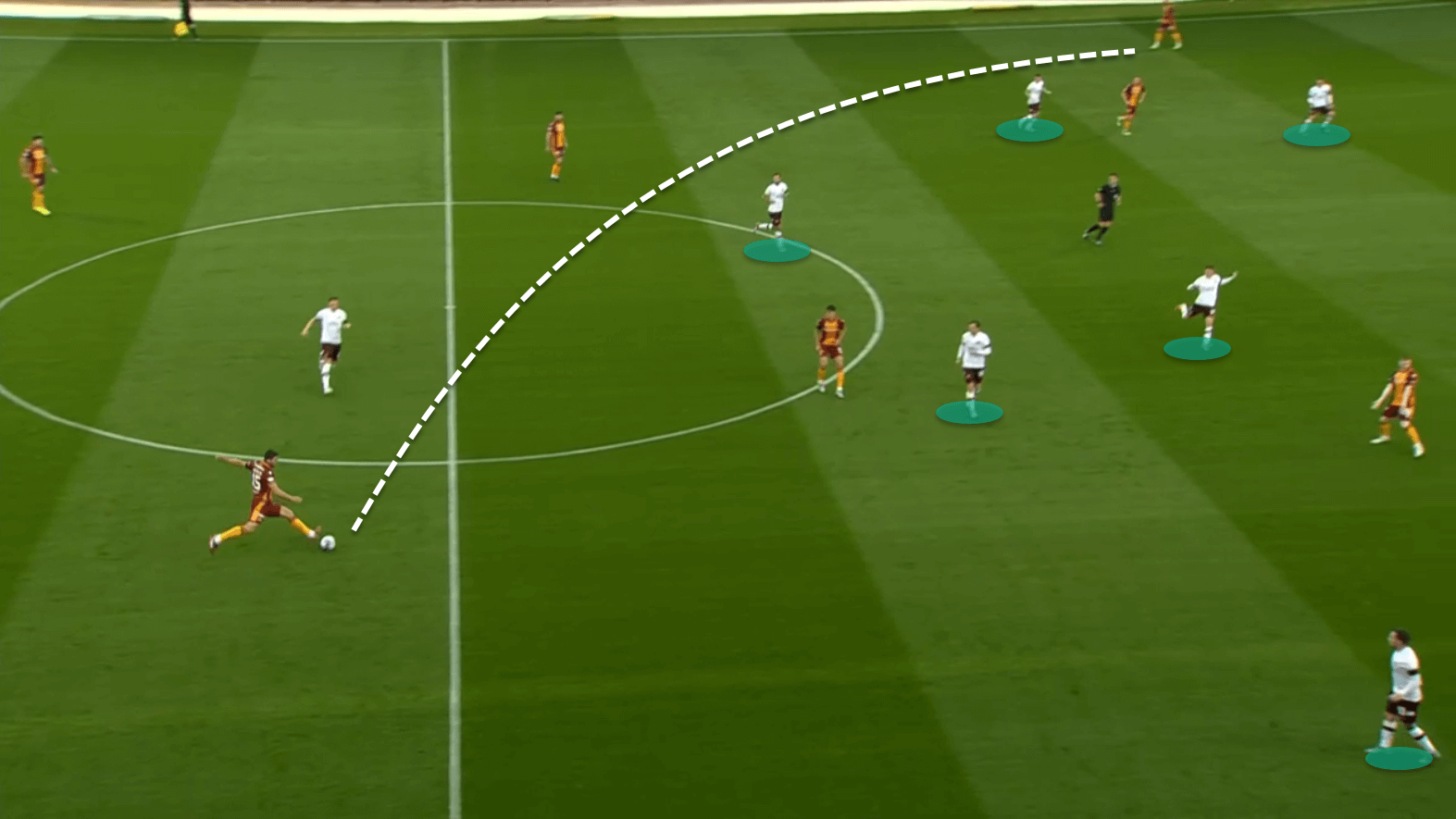

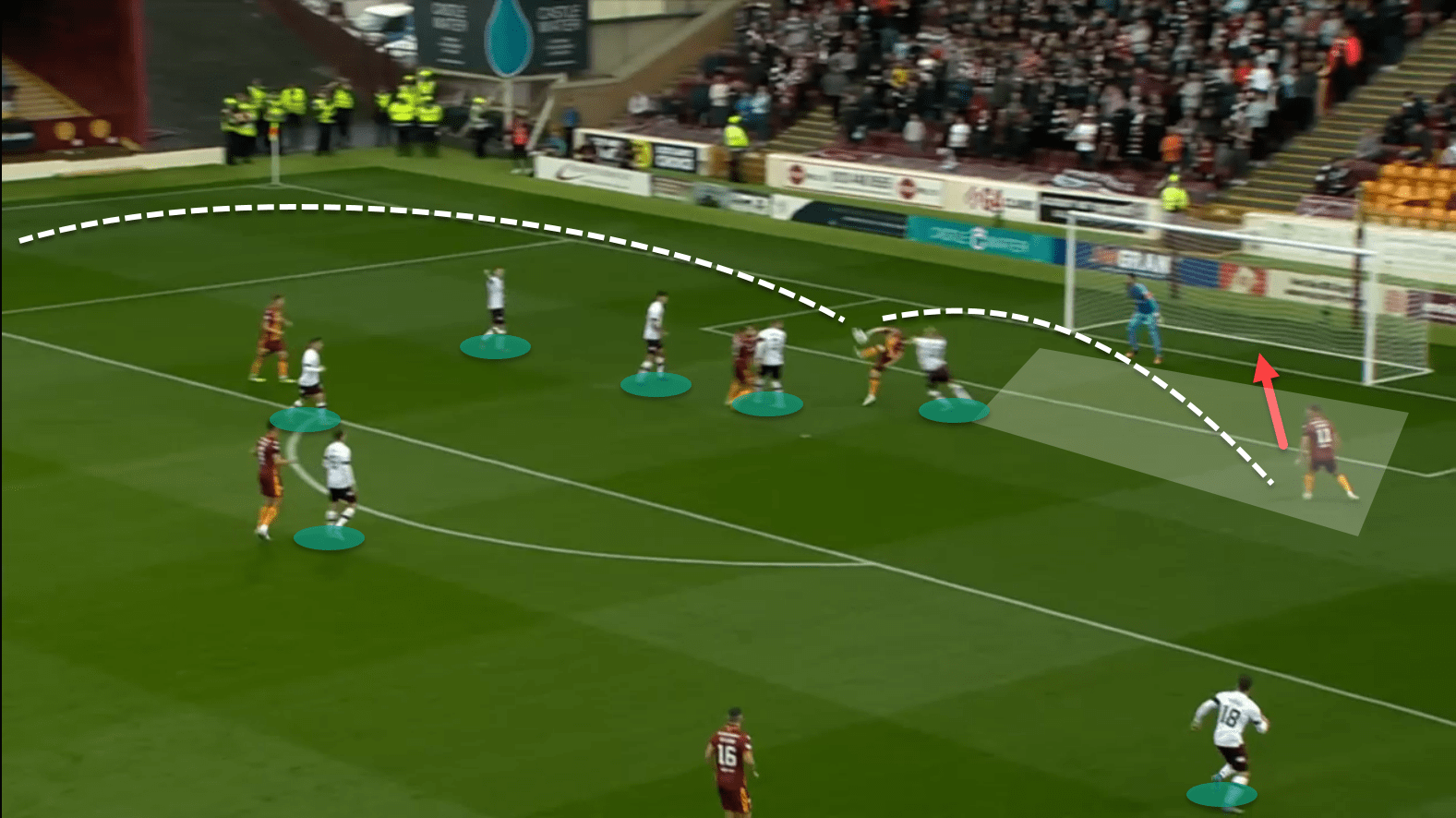
Key players
Hearts owe much of their league position to the quality of the players at top and tail, with Shankland and Gordon being in top form. Shankland is a recent addition to the Hearts side, joining from relegated Belgian side Beerschot in the summer, and has already scored 6 goals in 12 appearances in all competitions. Gordon returned to his boyhood club after leaving Celtic in 2020 to play more regularly after losing his place to Fraser Foster and was appointed as the club’s captain at the start of last season.
So far in the SPFL, Gordon has had an expected conceded goals (xCG) average of 1.21 per game, with a clean sheet percentage of 16.7% (putting Hearts at a poor joint 10th in the league for clean sheets), though he has saved 79% of shots, putting him second in the league behind Celtic’s Joe Hart, who has a slightly better save percentage of 80% and a clean sheet percentage at a much higher 71.4%.
Eager to rejoin Neilson after having his best season under him when winning promotion to the SPFL at Dundee United in 2019/20 (28 goals in 33 games, an 85% conversion rate), he has scored 4 goals in 7 appearances, sitting second in the league behind Celtic’s Liel Abada on shots on target per 90 minutes at 2.36, and sixth in the league for shots per 90 minutes at 3.43.
Conclusion
Neilson’s ability to adapt tactics and formation dependent on the opposition, demand, or constraints imposed on him are admirable and show a nous and determination that Hearts could benefit from in all areas of the pitch.
But with Craig Gordon at the ripe old age of 39 and with the promising Kye Rowes on crutches with a broken metatarsal, Hearts might be a little more vulnerable at the back this season. Some fans have come to the defence of Neilson’s tactics and claimed that the quality of players is lacking in some areas and individual errors have cost them points, but regardless of who they line up with, you can guarantee there will be goals galore.





Comments